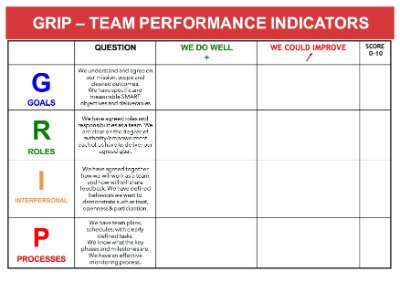Blog
Great teamwork is a key factor in delivering great business performance.
Leaders are constantly encouraging their teams to trust each other and work together for a common purpose because they know that engaged and motivated teams deliver great results.
So why is this so difficult to achieve? Why is it that so many teams somehow never find that magic recipe to achieve the alignment and sense of purpose that will make them high performing?
May be part of the answer is that team leaders just don't spend enough time working on the basics. Their focus is often on action and driving for results, but as we know from the world of sport, delivering great performance means working very hard at refining and practicing the basics.
High performing sport teams are totally engaged and aligned on their goals. Everyone in the team knows the part they are expected to play and what they have to deliver.
They know when they are performing well and have robust processes in place to review and adjust the way they play. But they also know when things aren’t going well and what they need to do when performance drops. They somehow find ways to discuss and resolve issues and move forward even if there is strong disagreement. This is an essential part of the alignment process and teams that don’t know how to disagree constructively, just don’t perform as well as those that do.
So how can leaders install good team practices in their own teams?
There are plenty of great processes to drive team performance, but the one that I find most powerful and really easy to use is the G-R-I-P High Performing Team Model which comes from Six Sigma’s change acceleration process tool kit and is widely used in GE and other organizations
G-R-I-P focusses on indicators that are equally important as the output and result KPIs that many teams tend to focus on.
In the performance review session, teams spend time individually, then collectively to share what they think works well and suggest changes to improve performance against the criteria:
GOALS: We have specific and measurable goals and deliverables...
ROLES: We have clearly defined roles and responsibilities in the team...
INTERPERSONAL: We demonstrate behaviors that trust between us...
PROCESSES: We have a plan with defined tasks, milestones and measures of success...
This seems like a very laborious process at first, because everyone needs to listen carefully and understand exactly what is being said. A lot of teams just don’t have the patience to do this and focus on what is not working.
What is really surprising for the team is how quickly quickly the exchange becomes more productive, with an increasing willingness to listen rather than talk.
The assessment process helps teams to identify what is working well and to propose suggestions for improvement.
The dynamic is of course completely different and orients the discussion in a positive way, helping individuals to say what really would be for them a good outcome.
I am always amazed when someone makes a suggestion for improvement instead of just observing what wasn't working. The impact on the rest of the team is often huge and for me this "what works well/what do we need to do to improve" mindset is key to getting consensus for change. Teams learn that they can bring their frustrations to the discussion and diversity of opinion becomes a positive force that drives consensus for what needs to change.
So maybe that “magic recipe” to get the alignment and sense of purpose that leaders are looking for, could just come through devoting more time to reviewing team performance... building trust, letting everyone have their say and allowing the team come up with the improvements that will deliver outstanding results.










